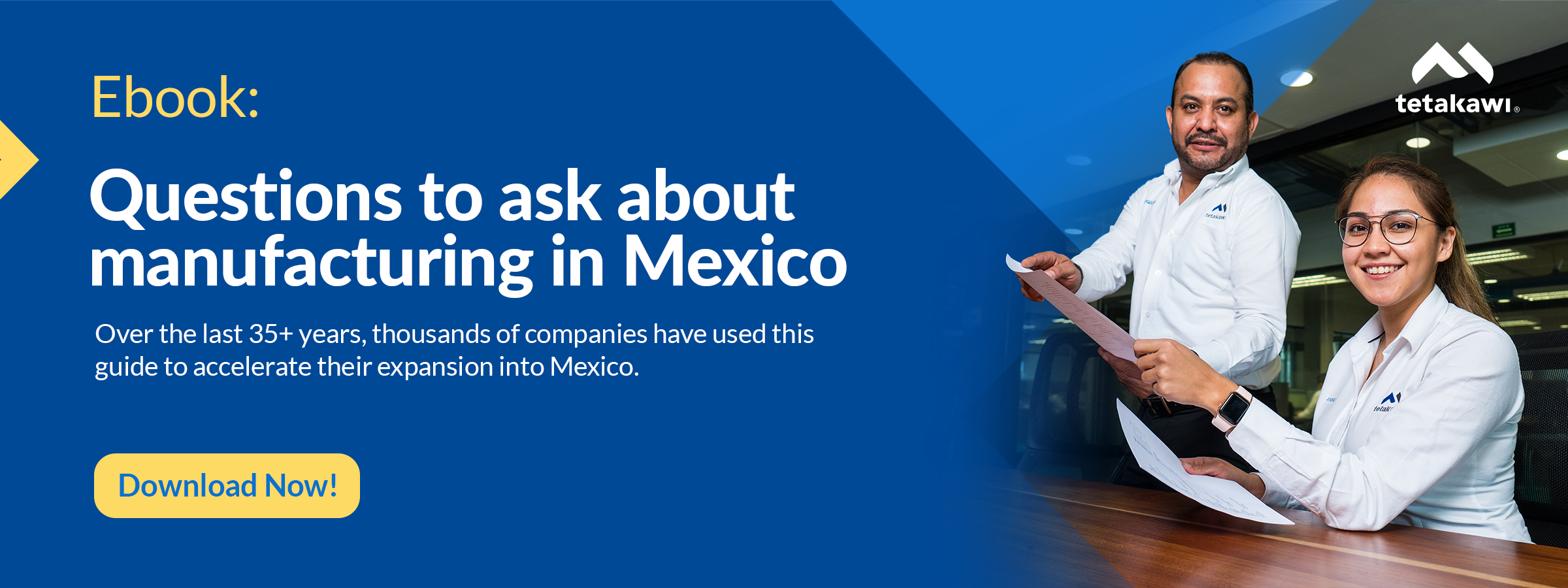Manufacturing companies are facing greater uncertainty around site selection factors than they have in decades. The offshoring model that has dominated manufacturing since the 1990s has proven inadequate in the face of multiple simultaneous disruptions that have contributed to service interruptions for many global companies.
Yet according to the State of Site Selection 2022, a research survey of site selection consultants conducted by the Site Selectors Guild and Development Counsellors International (DCI), industrial project activity continues at an “unprecedented rate.”
While each company faces unique factors in its site selection decisions, the Guild report addresses three primary issues that are currently driving industrial site selection decisions: workforce availability, risk mitigation strategies, and real estate readiness. These challenges happen to be three reasons that many manufacturers are taking steps to launch a factory in Mexico.
Listen to this podcast for more information about Site Selection in Mexico:
Workforce availability is driving site selection decisions
Workforce availability is far and away the leading consideration driving site selection decisions in 2023. For industrial projects, workforce availability was selected as a leading concern by 78% of survey respondents. It’s understandable, as the labor shortages that have plagued the manufacturing industry for years now are being felt more broadly across virtually all sectors.
The Guild report notes that the automation technology that has been viewed as a solution to this labor shortage brings its own challenges. First, automation technologies require their own reliable supply chain, a chain that is as much at risk of disruption as other manufacturers are facing. Second, fears that automation will eliminate manufacturing jobs have proved largely unfounded. Instead, it is driving a shift in the types of skills that workers need. As a result, the Guild predicts that access to established workforce training systems will be an important driver in site selection decisions. Workers will need training on building, operating, and maintaining increasingly more advanced automation and robotics solutions.
While labor costs have led many manufacturers to establish a factory in Mexico in the past, today, it is the stable demographics that prove most enticing. The country’s growth rate remains at more than 1% and is projected to remain stable for decades to come.
Moreover, Mexico’s investment in manufacturing includes a robust network of vocational and technical training institutions. A number of schools have strong ties to local manufacturers, including the Aeronautical University in Queretaro, launched with support from aerospace leader Bombardier, or the Universidad Tecnologica de Puebla and its apprenticeship program with Audi Mexico. Additionally, some Manufacturing Communities/Industrial Parks in Mexico provide space for onsite training facilities to help rapidly onboard new hires with advanced manufacturing skills.
In addition, many industrial parks in Mexico are laying the foundation for smart factory solutions. The Mexican Association of Private Industrial Parks has out a 2025 goal of having at least one-third of all industrial parks in Mexico fitted with high-added-value infrastructure to support Industry 4.0 manufacturers.
Watch this webinar to learn how to choose the optimal manufacturing location in Mexico:
Risk mitigation strategies are more important than ever
According to the Guild report, there has been a change in the types of risks that companies are assessing, which is driving a related change in response. First, the definition of “natural disaster” risks has expanded to include factors related to climate change. Second, the risks associated with climate change have extended to include transitional and liability risks.
Transitional risks include the potential cost to a business in complying with new policies and laws. A liability risk includes a business’ failure to comply with emerging laws, regulations, or policies designed to counteract climate change. As executives consider these expanded risks in their site location decisions, it may help to consider Mexico’s shelter service model.
A shelter service provider serves as the legal entity of record under which a foreign company can operate in Mexico. This partner takes on the administrative and legal tasks related to the foreign company’s business, leaving the foreign company to prioritize production-related activities. In this way, shelter service providers provide a tremendous competitive advantage to companies entering new regions and facing new risks.
Of course, there are other major risks pushing more companies than ever to consider a regional footprint. Geopolitical uncertainty, pandemic-related closures, and shipping disruption are all part of why 92% of Guild members reported in the survey that their clients are looking at new regional locations to shorten and risk-proof supply chains. In addition, 88% of those consultants reported that North American manufacturers are bringing production back to the U.S., Canada, and Mexico to reduce their reliance on Asian supply chains specifically, as this Asia-centric approach to manufacturing proved vulnerable to disruption during the COVID pandemic.
Real estate readiness remains an issue
Adding to the complexity around site selection decisions is a lack of real estate supply available in many areas to meet growing demand. The global construction industry is facing its own supply chain challenges, making it difficult to respond to demand and adding significantly to project timelines—despite many companies’ aim to shrink the time to launch in order to maintain competitiveness.
These site challenges are further compounded by resource shortages, including land, energy, and infrastructure readiness. The Guild report suggests that regions with a risk of utility disruptions may find themselves at a disadvantage when competing for projects.
The fix to this challenge may not be as immediately available, but regions dedicated to manufacturing are laying the groundwork for long-term stability. This includes investments in utility and transportation infrastructure projects.
Get the right data to make the best decision
While the Guild report notes that the site selection process remains fundamentally unchanged today, timelines are getting shorter and the volume of data available to support decision making has increased. Working with a partner who can help sift through the data most relevant to your needs, and knowledgeable in local site selection challenges, can be a significant advantage.
This is an area where Tetakawi stands apart. Our site selection services begin with a needs analysis that helps to understand how potential sites fit within your criteria and the potential cost of operation. This data helps companies maximize their chance of success in Mexico.
We invite you to learn more about Tetakawi’s site selection advisory services or contact us today.
Subscribe
Sign up and stay informed with tips, updates, and best practices for manufacturing in Mexico.




.jpg)
.jpg)
